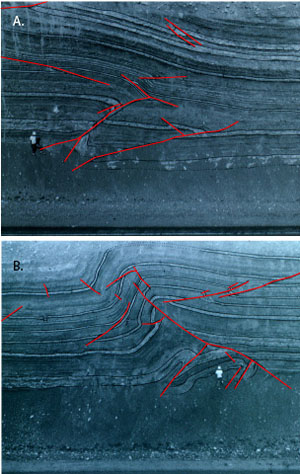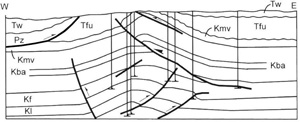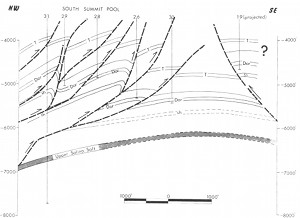| |||||||
|
|
|||||||
|
|
|||||||
| Multiple Thrust Fault Sets | |||||||
|
The patterns of multiple thrust or reverse faults are significantly different than those of other fault types. Though rare, conjugate thrust fault sets do exist as shown in Figure 1. There are several reasons for these differences as discussed under 'Mechanisms and Mechanics of Multiple Thrust Fault Sets.' Thrust faults form in response to a stress regime in which the maximum compressive stress is horizontal and the minimum principal stress is vertical (see, for example, Figure 1b under 'Multiple Fault Sets'). This, together with the vertical anisotropy in the mechanical properties of layered rocks in Earth's crust, induce other instabilities in the resulting deformation, namely buckling and bending either before thrust faulting or during, and sometimes even after the faulting. As a result most thrust faults are associated with folds to some degree (Figure 2 and Figure 3).
The other factor with considerable influence on the thrust fault patterns is the free surface or interfaces or weak gliding horizons on which thrust sheets with large transport are localized (Figure 4). The resulting geometry is such that the faults may be considered as flats along the weak surfaces or units and steep segments which represent the portion of the fault crossing the stiff unit's up section. Due to the limited strength of thin rock slabs or sheets, imbrications in the thrust fault patterns and stacking up the sheets are common. In this regard, one of the most common thrust fault patterns is the so-called thrust duplex which includes slabs or sheets bounded along the bottom and the top by sub-parallel thrust faults. Figure 4 also illustrates a tectonic deformation style predominantly confined within the sedimentary cover over a rather stable basement. This style without the involvement of the basement as far as large scale faulting is concerned, is called thin-skinned tectonics. On the other hand, Figure 5 is an example of basement involved thrusting or thick-skinned tectonics which is one of the characteristics of the Rocky Mountain region of the USA. In contrast to most multiple normal fault sets, there is a strong asymmetry in the large-scale thrust fault sets; the set verging to the transport direction dominates the pattern although what are commonly referred to as back thrusts, which have a vergence in the direction opposite to the overall transport direction, also occur. | |||||||
| Reference: |
|||||||
| Aydin, A., 1973 Gries, R.R., 1983 Groshong, R.H., Jr, 2006 Gwinn, V.E., 1964 Nickelson, R.P., Cotter, E., 1983 Suppe, J., 1985 |
|||||||
|
Readme | About Us | Acknowledgement | How to Cite | Terms of Use | Ⓒ Rock Fracture Knowledgebase |
|||||||




